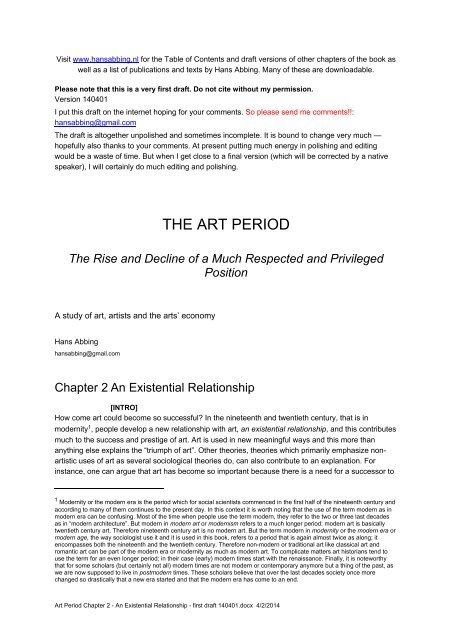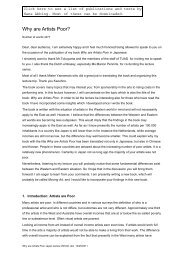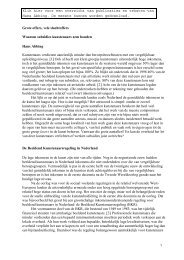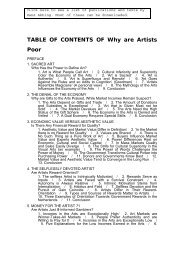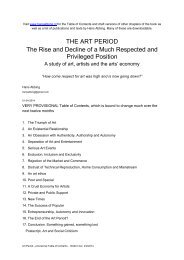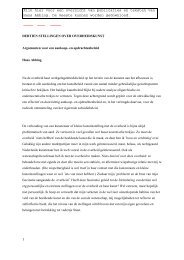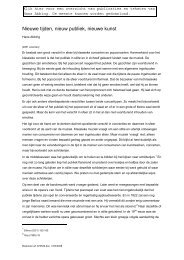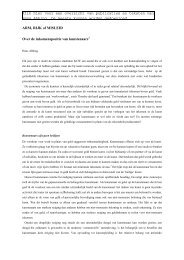First draft Chapter 2 - An Existential Relationship - Hans Abbing
First draft Chapter 2 - An Existential Relationship - Hans Abbing
First draft Chapter 2 - An Existential Relationship - Hans Abbing
You also want an ePaper? Increase the reach of your titles
YUMPU automatically turns print PDFs into web optimized ePapers that Google loves.
Visit www.hansabbing.nl for the Table of Contents and <strong>draft</strong> versions of other chapters of the book as<br />
well as a list of publications and texts by <strong>Hans</strong> <strong>Abbing</strong>. Many of these are downloadable.<br />
Please note that this is a very first <strong>draft</strong>. Do not cite without my permission.<br />
Version 140401<br />
I put this <strong>draft</strong> on the internet hoping for your comments. So please send me comments!!:<br />
hansabbing@gmail.com<br />
The <strong>draft</strong> is altogether unpolished and sometimes incomplete. It is bound to change very much —<br />
hopefully also thanks to your comments. At present putting much energy in polishing and editing<br />
would be a waste of time. But when I get close to a final version (which will be corrected by a native<br />
speaker), I will certainly do much editing and polishing.<br />
THE ART PERIOD<br />
The Rise and Decline of a Much Respected and Privileged<br />
Position<br />
A study of art, artists and the arts’ economy<br />
<strong>Hans</strong> <strong>Abbing</strong><br />
hansabbing@gmail.com<br />
<strong>Chapter</strong> 2 <strong>An</strong> <strong>Existential</strong> <strong>Relationship</strong><br />
[INTRO]<br />
How come art could become so successful? In the nineteenth and twentieth century, that is in<br />
modernity 1 , people develop a new relationship with art, an existential relationship, and this contributes<br />
much to the success and prestige of art. Art is used in new meaningful ways and this more than<br />
anything else explains the “triumph of art”. Other theories, theories which primarily emphasize nonartistic<br />
uses of art as several sociological theories do, can also contribute to an explanation. For<br />
instance, one can argue that art has become so important because there is a need for a successor to<br />
1 Modernity or the modern era is the period which for social scientists commenced in the first half of the nineteenth century and<br />
according to many of them continues to the present day. In this context it is worth noting that the use of the term modern as in<br />
modern era can be confusing. Most of the time when people use the term modern, they refer to the two or three last decades<br />
as in “modern architecture”. But modern in modern art or modernism refers to a much longer period: modern art is basically<br />
twentieth century art. Therefore nineteenth century art is no modern art. But the term modern in modernity or the modern era or<br />
modern age, the way sociologist use it and it is used in this book, refers to a period that is again almost twice as along; it<br />
encompasses both the nineteenth and the twentieth century. Therefore non-modern or traditional art like classical art and<br />
romantic art can be part of the modern era or modernity as much as modern art. To complicate matters art historians tend to<br />
use the term for an even longer period; in their case (early) modern times start with the renaissance. Finally, it is noteworthy<br />
that for some scholars (but certainly not all) modern times are not modern or contemporary anymore but a thing of the past, as<br />
we are now supposed to live in postmodern times. These scholars believe that over the last decades society once more<br />
changed so drastically that a new era started and that the modern era has come to an end.<br />
Art Period <strong>Chapter</strong> 2 - <strong>An</strong> <strong>Existential</strong> <strong>Relationship</strong> - first <strong>draft</strong> 140401.docx 4/2/2014
eligion; a religion which in the nineteenth century in a gradual process of secularization has lost<br />
some of its prominence in the daily lives of the bourgeois. Or —a very different type of explanation—<br />
art can have become so important because it enables a showing off in small circles or it enables a<br />
display of high status in wider circles. Or it can have become very important because art serves as a<br />
means for the bourgeoisie to symbolize and enhance their power vis-à-vis the aristocracy and/or the<br />
working class. There probably is some truth in all such theories and it is anyway unlikely that there will<br />
be just one explanation. But in my view a theory that takes art’s content into account and that what<br />
people get out of art, is vital for the explanation of art’s success.<br />
NEXT Say more about what is to come<br />
1. Expression in art is much appreciated<br />
In the course of the nineteenth century for many people art has become enjoyable and valuable by<br />
and for itself. This is an important additional use of art. The development is accompanied by a gradual<br />
change in the way art is understood and in the nature of some of the art produced. In this it is<br />
impossible to say what comes first. Do audiences demand a different type of art and do artists next<br />
provide it —this is what an economist would expect— or is it the other way around. Given the existing<br />
strong belief in art’s autonomy we —and art historians are no exception— tend to think that artists<br />
come first and that audiences follow. But artists are part of society and they respond to general<br />
developments in society. What is more likely is that at first only small groups of art consumers as well<br />
as small groups of artists —so-called avant-gardes— feel the need to respond to gradual changes in<br />
society, while next ever larger groups follow.<br />
In the course of the nineteenth century for an increasing number of artists the emphasis is no longer<br />
on a representation of reality (mimesis) but on expression and imagination. 2 At the same time an ever<br />
larger audience for expressive art develops. This leads to the emergence of new styles, like<br />
impressionist and modern art next to already existing styles. Romantic art which had emerged in the<br />
late eighteenth century has been a predecessor. In romantic art and even more in the later symbolist<br />
art representation is important but the art is foremost appreciated for its expressive qualities. —A<br />
typical painter belonging to the first category is Caspar Friedrich and to the latter Franz von Stuck.<br />
See pictures * and *.See picture “The guardian of Paradise” Wikipedia ??— [What about baroque music?? ≠ mimesis;<br />
check Braambussche or send him an email.]<br />
As long as the emphasis is on representation, the artist can be said to tell a story, while referring to<br />
publicly available reference points associated with widely shared moral convictions. At the time of the<br />
creation of, for instance, seventeenth century paintings art lovers know how to interpret these<br />
references. But in the course of the nineteenth century many artists, poets, playwrights, painters and<br />
composers start to express themselves and in this it is the “manner” rather than the story in the works<br />
that stands out.* 3 Stories in paintings, which demand existing knowledge of symbols to be properly<br />
understood, do not disappear, but the understanding of the stories has become less important. In<br />
literature there is far more reflection on personal experiences. Following Goethe writers like<br />
Dostoevsky and Proust regarded their entire oeuvres as being “confessional”. In the nineteenth<br />
century the number of auto-biographies increases much. Also musicians like Berlioz and Wagner<br />
write lengthy autobiographies. Moreover, much of the work of composers like Berlioz, Tchaikovsky<br />
and Mahler has an autobiographical reference. 4 All in all it is foremost the sensibility of the artist which<br />
is supposed to be articulated in his work and which is appreciated. The artist expresses his innermost<br />
2 Cf. (Taylor, 1991) 82-89 and (Doorman, 2004) (in Dutch) 152<br />
3 Nowadays it is more common to speak of form in opposition to content. By using the term manner instead of form (Taylor,<br />
1991) 82-89 draws attention to a wider social phenomenon by also taking into account the intentions, perception and values of<br />
both artist and art consumer.<br />
4<br />
(Blanning, 1969) 127<br />
2
feelings, his self in his work. [REMOVED (1) see below?] Work and artist have become inseparable. The<br />
artist is “in the work”.<br />
[SYNC with aura section]There probably is no art which is not at all expressive or does not express one<br />
way or another a personal view or a personal emotional state. 5 (Even in the oeuvres —rather than<br />
separate works— of conceptual artists, like Damien Hirst, a personal mark can be discovered.)<br />
Therefore also artworks of old can be appreciated for their expressive qualities. In music this certainly<br />
applies to the works of Bach but also to medieval madrigals; and in the visual arts to the Flemish and<br />
Dutch paintings from the sixteenth and seventeenth as well as many neoclassicist paintings.<br />
Appreciation of expression also applies to artworks in those earlier styles, which continue to be<br />
created in the nineteenth century, like in the visual arts history paintings, landscapes and genre<br />
paintings —depicting scenes from everyday life.<br />
This explains that not all works of art created in earlier centuries have become obsolete or turned into<br />
curiosities. But at the same time, not all works of old are as expressive in the eyes of the nineteenth<br />
and twentieth centuries’ art lovers. Therefore the new interest in expression has an impact on the<br />
selection of artworks which survive and still matter. —After all, the large majority of works has not<br />
survived, while many of those which have survived are not regularly reprinted, performed, or shown in<br />
the main rooms of museums.— The works which still figure and are put on a pedestal are often those<br />
which appear to be most expressive, personal and authentic. <strong>An</strong> example is the relatively expressive<br />
oeuvre of Johann Sebastian Bach, which is now performed far more often than that of his son, Carl<br />
Philipp Emanuel Bach, whose work at the time was more successful and more often performed.<br />
Given this type of selection art’s history is constructed and reconstructed. The latter even applies to<br />
the lives of the artists of old. When they are a bit adventurous this is highlighted, as in the case of<br />
Rembrandt and Mozart, and if they are ordinary, like that of Vermeer, they are made exciting, as in<br />
the film about Vermeer: The Girl with the Pearl Earring.* 6<br />
A reinterpretation also occurs in the case of primitive and prehistoric artifacts, like Venus ^figurines<br />
and African totems, and later on also the cave paintings, which are discovered *in the twentieth<br />
century. The works start to be perceived as artistically autonomous works and people imagine “artists<br />
at work who expressed themselves in the works”. Such works went through a process of re-valuation<br />
in successive stages. For instance, when in the eighteen’s century and before people stumble on<br />
such items, they perceive them as barbaric and of no value at all or at best as curiosities. In the late<br />
eighteenth century and the first half of the nineteenth century, however, they draw people‘s attention,<br />
but not as works of art but as archeological artifacts. They are useful for understanding the past, but<br />
their artistic value is zero. But in the second half of the nineteenth century and even more in the<br />
twentieth century they become works of art which share in the general high respect for art. Their<br />
artistic value (as well as financial value) becomes high.<br />
In short in the course of the nineteenth century, next to more mundane uses, art is increasingly also<br />
appreciated for its meaningful expression. People have use for expressive art. The question remains<br />
why this is the case? What more fundamental uses or purposes underlie the new interest in<br />
expressive art, and how do these uses relate to general developments in society?<br />
2. Art brings enchantment in a dis-enchanted world<br />
In modernity there are three closely related “longings” among the bourgeois which contribute to the<br />
high respect for art. The first, is a longing for a world which is enchanted and therefore the opposite of<br />
5 Cf. (Laermans, 2009) 132<br />
6 It is not true that before the art period people were not at all interested in the lives of artists. According to (Heinich, 2005) 119<br />
(in French) in the case of some artists, like **, an exceptional life or dedication added to the value attached to their works, but<br />
she emphasizes that these cases are not representative.<br />
3
the rational and bureaucratic daily world of the bourgeois. Art contributing to a re-enchantment of the<br />
world answers a need for compensation and escapism. Second, the topic of the following section, in a<br />
world in which there is an increasing specialization (division of labor) and in which people represent<br />
functions rather than that they have integrated personalities people long for freedom and an own<br />
identity, an indivisible self. Art consumption assists in this search. <strong>An</strong>d thirdly, the topic of the next<br />
section, in their very organized, restrained and controlled world people attempt to occasionally “loose<br />
themselves” and be in touch with their deepest emotions, be it in a controlled fashion and without<br />
others noticing. This is possible in a still and concentrated way of consuming art, foremost during<br />
performances and in museums.<br />
These longings for things which are hard or even impossible to attain can be said to be romantic. A<br />
romantic ethic is typical for modernity; it lasts to the present day. 7 This romanticism is therefore not<br />
tied to the Romantic Movement, which existed in a limited period with its center around 1810, or to the<br />
world of the so-called romantics and bohemians. <strong>An</strong>d it certainly does not only show from the<br />
appreciation of romantic or very expressive works of art. Nevertheless, it is true that the romantic and<br />
bohemian artists were the first artists to show off their personal freedom and lack of inhibition. It is a<br />
personal freedom we still associate with artists and which partly explains the attraction of the art<br />
profession. Artists are supposed to be free, they are freer than we are. Moreover, the bohemians of<br />
old still serve as an example for artists. To a degree all artists are now bohemians. Among others this<br />
often shows from the clothes of artists. For a long time they were and sometimes still are shabby,<br />
while the clothes of a new generation of cool artists are anyway eccentric.<br />
In modernity there is indeed a need for enchantment. 8 Whether to find compensation for the rational,<br />
alienating and dehumanizing demands of capitalist society or to temporarily escape from its “iron<br />
cage”* 9 , re-enchanting one’s world calls for imagination, the imagining of things and events which are<br />
absent in daily life, and art stimulates the imagination. Through reading books, watching paintings and<br />
listening to music doors are opened to other worlds. Often this is an earlier world and the longing is<br />
nostalgic. For instance, the bourgeois’ interest in impressionist painting is clearly nostalgic. In their<br />
urbanized world they long for nature. With these idyllic paintings on the walls in their houses they can<br />
reconnect with nature and so enchant their world. Though the paintings or photographs have changed<br />
this practice continues to the present. Pictures of nature —nowadays without human presence— still<br />
decorate the walls of the large majority of private homes. 10<br />
Even though in the perception of the bourgeois and later middle classes the arts represent an<br />
important source of imagination and creativity, for a long time art is not the only source. Especially in<br />
the nineteenth century there are forms of learning and entertainment which stimulate the imagination<br />
and bring enchantment. There are for instance journals with much attention for exotic countries or the<br />
mysteries of nature. Or there is a combination of learning and entertainment in the form of visits to the<br />
established dioramas and panoramas, which are enjoyable and certainly feed the imagination. But<br />
along with an increasingly strong separation of art and entertainment, for the nineteenth century<br />
bourgeois and for the upper middle classes of the first half of the twentieth century non-educational<br />
entertainment becomes taboo and art not only becomes the source of inspiration and imagination, in<br />
many ways it also becomes the only acceptable source. This separation of art, which is creative and<br />
stimulates the imagination, and entertainment, which gradually becomes to be regarded as stultifying<br />
7 (Campbell, 1987). Even more telling (Doorman, 2004) (in Dutch) speaks of a romantic order.<br />
8 (Weber, 1930) emphasized the process of disenchantment. Later sociologist, like (Campbell, 1987) and (Ritzer, 1999) drew<br />
attention to a simultaneous process of re-enchantment. The dialectical aspect of the latter has been emphasized by (Tiryakian,<br />
1992) 89. DOWN??*Aupers/Houtman or only in ch future??] of<br />
9 The term “iron cage” is a commonly used translation of the term “stahlhartes Gehäuse” used by Max Weber. (Weber, 1930)<br />
10 Cf. (Halle, 1993)<br />
4
and harmful for creativity and which can give people wrong ideas, contributes to the glory of art and<br />
the respect for art.<br />
3. A longing for freedom and an own identity<br />
[SYNC with ch autho..]In the nineteenth century an ideal of authenticity becomes important. 11 It is closely<br />
related to the ideal of personal freedom, which in modernity and up to the present day represents a<br />
central value in society. But personal freedom is not easily attained. The nineteenth century bourgeois<br />
long for another life in which they can be free, can freely express themselves or “let go”, and in which<br />
they can be and show their “selves”. But in practice they are forced to live formal lives, hold back their<br />
emotions and to do work in which they are replaceable. In the popular imagery this does not apply to<br />
artists. Artists express their true selves in their works and are thought to live authentic lives. Artists<br />
can realize what others can only dream of. This explains, at least partly, the high respect for art.<br />
The search for an own identity, a self, forms the core of the ideal of authenticity. In pre-capitalist<br />
society being an individual and being different from others was not something people were very aware<br />
of or strived for. At birth a child’s career was predictable. Most likely it would not differ from that of the<br />
parents. The son of the merchant would be a merchant and the son of the medical practitioner a<br />
medical practitioner. What stood out was the collective, not the individual. A person felt part of a<br />
collective, which defined him, and this sufficed. There was more attention for sameness than for<br />
difference. 12<br />
But with increasing competition, specialization and rationalization of production in both industry and<br />
administration one’s place in society is no longer given and a person stops being a well-defined<br />
member of society. Over time the division of labor and the functional differentiation only increases,<br />
and having to perform activities as part of a production chain a person becomes an impersonal and<br />
largely accidental collection of functions instead of an integrated person. 13 The interchangeability in<br />
the functions makes him anonymous; it de-humanizes him and he becomes alienated. This is painful.<br />
and it is therefore understandable that individuality and an own identity become ever more important.<br />
People search for an indivisible being, a self.<br />
In the imagination of people the self is more than the sum of many separate characteristics. It is a<br />
meaningful overall identity, which is personal and unique and as such differs from that of anybody<br />
else. But the whole, that is the self, is also impalpable and elusive. There is an assumption of a<br />
unified whole with an indivisible core, but if the core really exists is uncertain, and what characterizes<br />
it is hard to grab.[CHECK Giddens and Taylor] All the time there is existential doubt. Do I have an individual<br />
soul; do I really differ from others? People search for an own true self, but finding it is hard, if not<br />
impossible.<br />
This applies to “normal” people. In the common view this does not apply to artists. They are free and<br />
do not suffer from the compartmentalization capitalism imposes on others. They do not need to<br />
restrain themselves, at least not as much as others. When creating art, they let go, were somewhat in<br />
contact with their inner self and so expressed their emotions and their self in their works.<br />
[SYNCED well enough with ch authenticity?? CHECK again.]When artists express their selves, they can also be<br />
said to realize themselves. During the art period self-realization is, next to authenticity, an important<br />
objective of people, which is hard to attain. In having access to their selves, in being able to express<br />
their selves and in realizing themselves artists are thought to succeed where others cannot. Artists do<br />
11 Cf. (Taylor, 1991) He has so-called expressive authenticity in mind rather than nominal authenticity —see Section *. When I<br />
use the term authenticity without explication it is expressive authenticity.<br />
12 (Taylor, 1991) 47<br />
13 It is foremost (Simmel, 1978) (in German) who analyzed the process of individuation from the perspective of people being<br />
functions rather than integrated beings. According to him in the modern world, the larger culture and all its various components<br />
(including the money economy) expand, and as they expand, the importance of the individual decreases.<br />
5
what many others long for but aren’t capable of doing: express an individual point of view or a<br />
personal emotional state. 14 This as well explains the respect and admiration for artists —and often<br />
envy as well. It also, partly, explains why it is so attractive to become artist. The widely shared belief<br />
that artists have a divine calling or are gifted by nature, and so are able to be in touch with their inner<br />
self, adds even more to the admiration, and probably also to the conviction that for ordinary not-gifted<br />
people finding one’s self is hard if not impossible. It is anyway not accidental that in the nineteenth<br />
century the ineradicable myth of the artist as genius emerges. 15<br />
Also at a more superficial level artists have an advantage. Even if anybody could be unique in a<br />
meaningful and authentic way, artists can give proof of their uniqueness and authenticity. It appears<br />
that artists and their works are irreplaceable, while even major *captains of industry are. If tomorrow<br />
the *chief executive of Sony dies, the next day there will be another and it is business as usual; the<br />
nature of production and the product does not change. Such executives may have a somewhat<br />
personal style, which can be valuable, but ignoring a few exceptional cases —Steve Jobs?— they are<br />
replaceable. Their signatures have value, but only because of their function, while in the case of<br />
artists signatures have value because of a (sometimes imagined) personal mark. Because of their<br />
authenticity the artist and his work are irreplaceable. When David Hockney dies there will be no more<br />
Hockneys.<br />
A search for an own identity, an authentic self through art consumption may appear a farfetched idea.<br />
I think it is not; it is almost always present but often it so automatic or natural that one is hardly aware<br />
of it. But occasionally the experience is so strong that one remembers it for years. I remember that in<br />
*1964 —I was 18— during a visit to the Tate Gallery in London I looked for quite some time at<br />
Turner’s painting Rain, Steam and Speed —see picture *. The painting “touched” me, or rather I let<br />
the painting touch me. In the painting and in my head the rain and steam are chaotic while the<br />
depicted train has speed, is powerful and has direction. I remember thinking: “this is who I am; who I<br />
deep down am; I am chaotic and I could have direction”. Also on several occasions listening to<br />
symphony music in a concert hall I had similar experiences though rather as a general mood than a<br />
clear realization. The sequence of the music in the typical nineteenth century symphony is<br />
predominantly a chronological recording of the fight between order and chaos, between good and evil;<br />
a fight in which after much struggle the former defeats the latter. @In the first part →→→, next in the<br />
second→→→ and then there is the triumphant finale. 16 After a scary, but also attractive voyage into<br />
the world of evil, both in the world surrounding me as inside of me, I came out strengthened: “Deep<br />
down, this is me” and “I can overcome”.<br />
It appears that in internalized conversation artworks talk back to us. Because the projection of feelings<br />
and thoughts on works of art is so important for our appreciation of art and for our existential<br />
relationship with art in the art period, I say a bit more about internal conversation. Conversation<br />
implies interaction. This also applies to internal conversation and to possibly all forms of thinking. As<br />
Herbert Mead argues, when people think they are talking to themselves or to imagined others.<br />
According to him thinking is internal conversation between parts of the self. These can be an ‘I’ or<br />
‘me’ or a specific or generalized ‘other’ or ‘others’. 17<br />
Therefore an artwork can be said to talk back to us, or rather: an artwork and/or parts of it and/or the<br />
imagined artist can take part in a conversation. For instance, in an abstract painting the left top corner<br />
may disagree with the spectator (or even with another part of the painting) or exchange ideas and<br />
14 (Laermans, 2009) 132<br />
15 (Doorman, 2004) (in Dutch) 114<br />
16 (Small, 1998) →→***<br />
17 (Mead, 1934). (Collins, 2005) *305, *318-20 also emphasizes the interactional aspect in thinking, even when there may not<br />
be dialogue.<br />
6
emotions with him (or it). Maybe a part may turn into a parent or sister or another specific other, or it<br />
becomes a generalized other like parents in general. <strong>An</strong> internal conversation develops. This is also<br />
what can be expected, because we scan paintings and so explore them over time, the same as we<br />
listen to tones and melodies or read words and lines one after the other. This way a person can<br />
indeed be said to embark on an inner directed journey which enrolls along with the developments in<br />
the book, play, and music or dance performance or along with the eye movements in the case of a<br />
painting.<br />
When the work of art “talks back”, many things may happen. For instance, in the course of the<br />
conversations there can be attempts to resolve a personal problem. If they are unsuccessful the<br />
problem remains unresolved, and then the artistic experience may well be frustrating. But it is also<br />
possible that the conversation develops well and the overall outcome is a form of agreement or<br />
reconciliation between different parts of the self. The result is then the kind of harmony or unity, which<br />
many people associate with art experiences.<br />
4. Art serves the exploration and sublimation of hidden desires and emotions<br />
It is also possible to look at the ideal of authenticity from a slightly different angle, that of self-control,<br />
self-discovery and sublimation. 18 In their rational and well-ordered society much self-control is<br />
demanded from the nineteenth century bourgeois and the later middle classes. Given ever increasing<br />
cooperation and competition —as part of an ongoing civilization process 19 — behavior has to be<br />
rational, predictable and trustworthy. But the self-control simultaneously calls forward not only the<br />
sublimation of emotions but also attempts to discover one’s emotions and one’s self. In order to know<br />
“who one really may be” a journey into the subconscious may be called for.<br />
Usually the necessary formal and restrained behavior of the bourgeois and later middle classes does<br />
not require much effort; it is largely automatic. Due to their upbringing and education they have<br />
internalized many explicit and implicit rules ——social scientists call this socialization.[Out. elsewhere?20]<br />
But in the course of the art period people also start to experience discomfort. 21 This encouraged a<br />
belief in the existence of a possible parallel personal world in which there is less need to restrain<br />
oneself.<br />
The bourgeois searched for an inner world, which was less controlled and more their “own”, and<br />
therefore more authentic. They embark on journeys of self-discovery. Usually these serve the uncovering<br />
of a pre-existing self. Art consumption could enable such journeys. Attempting to un-cover<br />
the work-within-the-work and thus the artist’s true expression of his self could help finding one’s own<br />
hidden self. Living authentic lives is no option, but being in contact with a presumed self is.<br />
The bourgeois are required to hold back in their interaction with others. But in art consumption giving<br />
in to impulses and emotions is possible and attractive as long as others do not notice. Telling of the<br />
combination of control and emotion is the image of a crowd of silent people sitting erect with straight<br />
backs on chairs in perfectly straight rows in a square hall listening motionless to highly emotional<br />
romantic music, which probably touch them deeply, but outwardly showing no emotion. Orderly,<br />
controlled and altogether motionless the bourgeois and upper middle class listen to the music, and<br />
18 (Levine, 1988) *-* emphasizes [CHECK] that the modern bureaucratic society demanded order. This showed in very different<br />
spheres of life from the classification of animals in higher and lower species, orders and families and the orderly lay out of<br />
public parks to the developments of canons.<br />
19 (Elias, 1994).<br />
20 The term socialization refers to a process of inheriting and disseminating norms, customs and convictions, which enable an<br />
individual to successfully participate in society in general as well as in smaller circles within society.[Check with wilterdink<br />
and/or *ritzer]<br />
21 One could argue that a maximum in adaptation has been reached, Social biologists, like for instance (Tiger & Fox, 1997)<br />
argue that given human evolution there exist natural constraints which sets limits to a wide spectrum of cultural possibilities.<br />
Generally this spectrum is indeed wide, but closer to the limits discomfort arises.<br />
7
guided by the motions in the emotional music they embark on personal journeys. At such moments<br />
emotions are strong but other than in the music it does not show.<br />
Whereas the un-covered work-within-the work can be light and elevating, it can also be dark and<br />
mean, as can be the true self of the artist as expressed in the work. —Romantic artists often were<br />
fascinated by violence and there works could easily express darkness.* 22 — The same can apply to<br />
what one un-covers in oneself. Therefore backs are not only erect to prevent movement and the<br />
showing of emotions; they were also erect to remind the listener of the here and now; to keep him<br />
from losing himself altogether in a world of great personal victories and invincibility, beauty and<br />
fantastic hidden treasures or, instead, of misfortune, peril and inner evil, as in the case of primitive<br />
sexual fantasies. The own soul can be “a yawning abyss, an immense collection of caves full of<br />
desires, hidden horrors, but also unexpected treasures.” 23 But the straight chairs and all the other<br />
erect bodies around him make it easier for him to return safely from a dangerous journey.<br />
In Freudian terms the internalization of rules of behavior and the resulting strong self-control in the<br />
daily interaction with others generally implies the repression of feelings. At the same time along with<br />
the increasing popularity of Freudian theory some awareness and knowledge of the hidden or<br />
subconscious is increasingly thought to be a good thing. This can be attained by reading poems or<br />
books or visiting the concert hall, theater or museum, while at the same time such activity can lead to<br />
a sublimation of the dangerous feelings.<br />
“My” father, who was a reverend, evidently did not think that an awareness of his own feelings was a<br />
good thing. I remember how, when I was very young, my father would sit in a chair with eyes closed<br />
listening to the voice of Elisabeth Schwarzkopf coming from the gramophone. I sometimes wanted to<br />
join him, but my father always sent me away and would not say why. I questioned him about this<br />
again when he was an old man. He then told me that listening to Schwarzkopf had been attractive for<br />
him, too attractive. He experienced not only heavenly feelings but also erotic feelings and this<br />
confused him and made him feel ashamed.<br />
Finally, it should be noted again that a high respect for art-in-general does not imply that the respect<br />
for all artworks or all genres or all artists is high. Art-in-general has much goodness in the nineteenth<br />
century, but not always. It did not apply to all artworks and all artists. Given what artworks and artists<br />
could unleash, there was also resistance and at times disgust. This shows from both the high respect<br />
for some artists and the disrespect for other artists, or sometimes for the same artist at different<br />
moments. This is somewhat comparable with the recurring perception of women: the artist is saint<br />
and whore almost at the same time. But, as noted, disrespect as well shows how value laden an<br />
object is.<br />
Artists figure in the life of the bourgeois and upper middle class in a positive as well as negative way.<br />
They are welcome guest in the saloons, but in the eyes of the bourgeois the more intense contact<br />
which artists were thought to have with their inner self can also represent a threat to their and their<br />
family’s well-being. It can encourage them to a permanent giving in to bad inclinations. This is what<br />
the bourgeois associate with the loose and free life-style of the bohemians, or what they and the later<br />
middle classes associate with the lifestyle of actors and actresses. Even if artworks themselves were<br />
not evil, the contact with such artists and the world-of-art can be dangerous (and daughters must<br />
certainly not become actresses).<br />
Moreover, also in a less debauched fashion the contact with artworks and artists can bring evil. The<br />
story of the prosperous bourgeois and mercantile house of the Buddenbrooks in Thomas Mann’s<br />
22 * (Tiryakian, 1992) 84-5 [*CHECK wording Tir and INSERT reference to texts Van Os on Romanticism. Also Doorman?<br />
(Doorman, 2004)]<br />
23 (Doorman, 2004) (in Dutch) 32 [Recheck for proper translation: yawning abyss].<br />
8
novel shows how the world-of-art gradually weakens the house and finally brings it down. 24 <strong>An</strong>d again<br />
there is attraction. For Hermann, the son of the founding father, who is even more prudent and<br />
conformist than the father, the world-of-art nevertheless holds attraction as shows from his marriage<br />
with his musical and somewhat eccentric wife; and though he tries, he is not able to change the<br />
artistic and “weak” inclinations of his own son. He rejects them and he fears, rightly so, that they can<br />
bring down the family business.<br />
5. Art does not simply replace religion or is the counterpart of science<br />
Discussing the role of art in modernity sociologists use terms like sacralization, consecration, aura,<br />
sacred, sacredness and even redemption and salvation. Although for sociologists these terms are not<br />
tied to religion or the supernatural. —for instance, sacred usually means just “worthy of respect”— the<br />
use of such terms can be confusing due to their religious connotation. It may suggest that art is the<br />
almost inevitable successor and replacement of religion and that secularization has led to a prominent<br />
place for art. This appears to make sense.<br />
<strong>First</strong>, even though for a long time most bourgeois and many artists, like * and *, remain convinced and<br />
practicing Christians, it is true that in public life and public space the position of the church becomes<br />
less prominent while that of art becomes more prominent. With a few exception no more religious<br />
cathedrals are built, while art cathedrals spring up all around. Second, given secularization, art could<br />
have been a welcome successor because of a persistent need for a possibility to escape from an<br />
unpleasant here and now. Novalis writes: “Whoever feels unhappy in this world, whoever fails to find<br />
what he seeks—then let him enter the world of books, the arts and nature, this eternal domain which<br />
is both ancient and modern simultaneously, and let him live there in his secret church of a better<br />
world. There he will surely find a lover and a friend, a fatherland and a God.” 25 Note the use of the<br />
words church and god.<br />
But there are differences as well. Society has changed fundamentally and the role of art differs<br />
fundamentally from that of religion as do the uses which people have for art. The relationship people<br />
have with art is another one than the relationship people had with religion. It is therefore telling that for<br />
Novalis it is a secret and private church which is not shared with others, while her god is a god. The<br />
choice of books or music or paintings is personal. There is not just a single book which is shared with<br />
all other believers, while the bible is the word of a single god, a god in which people believe<br />
collectively rather than as individuals with individual identities. The same as the art from before the art<br />
period, religion relies on widely shared reference points and values. But, unlike in the later arts, there<br />
is little space for individual values and a personal truth.<br />
When it comes to truth in general, all through the art period the sciences appear to have more to offer<br />
than both religion and art, but its truths stand for rationality and demystification (even though, seen<br />
from outside, there probably was and is much enchantment and charm to be found in the sciences).<br />
Moreover, they offered (too) many truths and, again, no personal truth. The new relationship with art<br />
is, indeed, existential. People search for personal meanings to understand a personal existence in the<br />
world.<br />
But at the same time, as noted, in practice art continues to be used for constructing moral meanings,<br />
for notions of good and bad and thus for guidance and advice, even though at present this is not<br />
emphasized, covered up or denied by established artists and art experts,. The same as in religion the<br />
moral meanings may well be widely shared. Nevertheless, I think that during the art period people<br />
24 Ref. [here and not in list]<br />
25 (Blanning, 1969) 130<br />
9
take more liberty in constructing personal truths and personal moral advice when they consume art<br />
than they earlier did when “consuming” religious things.<br />
All in all there appears to be both overlap and difference when art, religion and science are compared.<br />
This is particularly clear in art experiences in which the self or the discovery of the self appear to be<br />
unimportant. For instance, the goal can be the opposite: to lose oneself in art works and to<br />
temporarily fulfill a wish to be part of the universe. This is what certain listeners to classical music or<br />
people who are particularly fond of color field paintings like those of *Mark Rothko report —see<br />
picture *. The same as in religion, but also in other art consumption a form of escapism is involved.<br />
The experience brings relaxation, if not redemption. But what is one escaping from? It can well be the<br />
forceful requirement in modernity to be a collection of useful functions rather than an integrated<br />
individual. By escaping, these art consumers may well find their true private as well as cosmic self by<br />
experiencing “wholeness”. It is therefore likely that an escape from the world and a finding oneself in<br />
the world can supplement one another. 26 Schopenhauer’s idea of music serving the penetration in the<br />
depth of the own psyche and Nietsche’s and Wagner’s penetration in the Weltgrund can well go<br />
together. 27 In both people believe they get in contact with their core or true self. <strong>An</strong>d also today<br />
standing in front of a symbolist painting by Friedrich or an abstract painting by Mondrian or listening to<br />
a symphony by Beethoven or a musical piece by Satie, the reader may well experience the two<br />
aspects almost simultaneously.<br />
6. In the twenty first century however art has lost its monopoly on creativity and<br />
authenticity<br />
Section still to be written.<br />
--------------------<br />
Blanning, T. C. W. (1969). The commercialization and Sacralization of European Culture in the Nineteenth Century. In T. C. W.<br />
Blanning (Ed.), The Oxford Illustrated History of Modern Europe. Oxford: Oxford University Press.<br />
Campbell, C. (1987). The Romantic Ethic and the Spirit of Modern Consumerism. Oxford: Blackwell.<br />
Collins, R. (2005). Interaction Ritual Chains. Princeton and Oxford: Princeton University Press.<br />
Doorman, M. (2004). De Romantische Orde. Amsterdam: Bert Bakker.<br />
Elias, N. (1994). The Civilizing Process. Oxford: Blackwell, 1993.<br />
Halle, D. (1993). Inside Culture, Art and Class in the American Home. Chicago: The University of Chicago Press.<br />
Heinich, N. (2005). L’Élite Artiste, Excellence et Singularité en Régime Démocratique. Paris: Gallimard.<br />
Laermans, R. (2009). Artistic Autonomy as Value and Practice. In P. Gielen & P. de Bruyne (Eds.), Being an Artist in Post-<br />
Fordist Times (pp. 125–137). Rotterdam: NAi Publishers.<br />
Levine, L. W. (1988). Highbrow/Lowbrow: The Emergence of Cultural Hierarchy in America. Cambridge , Mass.: Harvard<br />
University Press.<br />
Mead, G. H. (1934). Mind, Self and Society. Chicago: University of Chicago Press.<br />
Ritzer, G. (1999). Enchanting a Disenchanted World: Revolutionizing the Means of Consumption. Thousand Oaks: Pine Forge<br />
Press.<br />
26<br />
(Campbell, 1987) 181-2 speaks of two closely connected forms of faith: “a pantheism with regard to nature at large and a<br />
purely personal drama of redemption to be acted out within the confines of one’s own being.”<br />
27 *CHECK Cf (Doorman, 2004) 31 (in Dutch)<br />
10
Simmel, G. (1978). The Philosophy of Money. London: Routledge and Kegan Paul.<br />
Small, C. (1998). Musicking. The meanings of Performing and Listening. Middletown, Connecticut: Wesleyan University Press.<br />
Taylor, C. (1991). The Ethics of Authenticity. Cambridge: Harvard University Press. In 2005 the book was reprinted under the<br />
title Three **** of Modernity.<br />
Tiger, L., & Fox, R. (1997). The Imperial <strong>An</strong>imal. Henry Holt & Company.<br />
Tiryakian, E. A. (1992). Dialectics of Modernity. Reenchantment and Dedifferentiation as Counterprocesses. In H. Haferkamp &<br />
N. J. Smelse (Eds.), Social Change and Modernity. University of California Press.<br />
Weber, M. (1930). The Protestant Ethic and the Spirit of Capitalism. (T. Parsons, Trans.). (Translated by Talcott Parsons)<br />
London & Boston: Unwin Hyman, URL: marxists.org/reference/archive/weber/protestant-ethic/index.htm. Retrieved<br />
from marxists.org/reference/archive/weber/protestant-ethic/index.htm<br />
11


